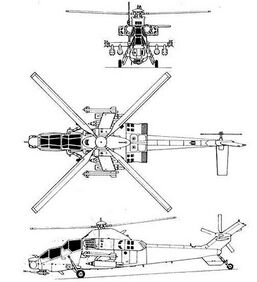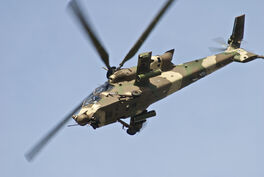The Denel AH-2 Rooivalk is an attack helicopter of South African Air Force (SAAF, An acronym for South African Air Force).
Description[]
South Africa has shown a great capacity to develop their own weapon systems due to an international arms embargo that was in effect during the 1970s and -80s. By that, South Africa's industry has grown so far that today it can be considered one of the major players of the world's military development.
The combat helicopter AH-2 Rooivalk was designed and developed by Denel, the leading aerospace manufacturer in South Africa, following a request of the South African Air Force (SAAF) who pronounced the need for a dedicated attack helicopter. The

A diagram of the AH-2 Rooivalk
experience of suffering from an arms embargo showed the need to development of a local helicopter since importing a ready-made aircraft was not possible. Atlas, the predecessor of Denel, assembled a prototype attack helicopter called the XH-1, based on the Alouette III, but the model was not potent enough for the requested mission. So, another prototype, this time based on the Puma transport helicopter's cell, was built under the name of XTP-1 and subsequently renamed the XH-2. Currently, the definitive name for the production model is AH-2 Rooivalk.
Altogether only 16 units of the Rooivalk were built. The model was offered to England and even Brazil, but without success. The market for attack helicopters is relatively small and the models that tend to get some commercial success are usually produced by countries with a more established weapons industry such as the United States and Russia. The Rooivalk is powered by two French Turbomeca Makila 1K2 turbines that produce a power of 2301 shp each. This turbine is a version of the same turbine used in the Super Puma transport helicopter. The Rooivalk can reach a top speed of 309 km/h and therefore a bit faster than the Apache, considered by many as the best combat helicopter today.
Eletronics[]
The Rooivalk is equipped with an electronics suite that allows the helicopter to operate day and night and in all weather conditions, consisting of a multi-sensor turret in the nose of the helicopter called TDATS. This system includes a FLIR (Forward Looking

The cockpit of the Rooivalk is configured with color multifunction displays, following the trend in this type of aircraft. The work crew is greatly facilitated by automation systems and the presentation of the tactical situation on the monitors.
Infrared) or infrared vision display, a TV viewer for images in low light and a target designator/laser rangefinder for guiding weapons. The Rooivalk is also equipped with a suite of communication system consists of a UHF / VHF and HF radio for voice communication and data. There is also an IFF-system for friend-foe identification installed. Full avionics suite to a GPS.
Armament[]
The armament of Rooivalk is directed toward tactical air support and to destroy armored vehicles. The main armament for this missions ist the South African Denel ZT-6 Mokopa anti tank missile. The Mokopa h

The wide availability of power allows the Rooivalk aerobatic flying safely.
as a range of 8 km, which is equal to the similar North American AGM-114 Hellfire, used in the Apache. The Mokopa missile features a tandem warhead (one behind the other) optimized for penetrating the modern reactive armor (ERA) widely used by Russian and some Middle Eastern armored vehicles. The Mokopa is a semi-active laser guided missile, which requires the helicopter or an other element of the strike force to illuminate the target with a laser designator during the entire course of attack. Rooivalk can use the AGM-114 Hellfire missile and the European HOT-3, too, in stead of Mokopa.
To attack ground targets unguided 70 mm rockets may be used. Their launchers can hold 36 or 72 rockets each. The Rooivalk can also fight other helicopters using heat seaking Mistral missiles with a range of 6 km. In addition to these weapons the Rooivalk is equipped with a gas operated 20 mm caliber M-2 cannon with 700 rounds of ammunition, fixed under the nose. This cannon fires at a rate of 740 rounds per minute and is used against light armored troops and other enemy helicopters, Rooivalk's most likely targets.
Specifications[]
General Characteristcs[]
- Crew: 2 (pilot & weapon systems officer)
- Length: 18.73 m, 61 ft 5in (main rotor to tail rotor); 16.39 m fuselage ()
- Rotor diameter: 15.58 m (51 ft)
- Height: 5.19 m (17 ft)
- Empty weight: 5,190 kg (11,441 lb)
- Max takeoff weight: 8,750 kg (19,290 lb)
- Internal fuel capacity: 1,469 kg, (3,238 lb)
- Powerplant: 2× Turbomeca Makila 1K2 turboshafts, 1,492 kW (sea-level ISA) (2,001 shp) each
Performance[]
- Maximum speed: 309 km/h (193 mph)
- Range: 700 km combat; 1,130 km ferry (440 mi / 700 mi)
- Service ceiling: 6,000 m (20,000 ft)
- Rate of climb: 13.3 m/s (2,105 ft/min)
- Disc loading: lb/ft² (kg/m²)
- Power/mass: hp/lb (kW/kg)
Armament[]
- 1 x F2 20 mm cannon, 700 rounds
- 8 or 16 x Mokopa ZT-6 long-range anti-tank guided missiles (ATGM),
- 4 x MBDA Mistral air-to-air missiles,
- 36 or 72 x 70 mm folding fin aerial rockets (FFAR)
See also[]
The original article can be found at Denel AH-2 Rooivalk and the edit history here.